Traveling in an RV is a statement all on its own. It’s a way to tell yourself and others that it’s not just about the destination but about the journey. But you won’t enjoy the journey very much if you’re hot and sweaty through most of it. That’s why it’s so important to have a dependable air conditioner installed in your recreational vehicle.
We’ve put together this guide to cover everything that you need to know about air conditioning for your RV. Before getting to our recommendations of the best products, let’s find out what you need to know before making that decision for yourself.
- What You Need to Know Before Buying an RV Air Conditioner
- Top 10 Best RV Air Conditioners 2026
- 1. Best Overall RV Air Conditioner: Dometic Brisk II
- 2. Best Budget RV Air Conditioner: Frigidaire White Energy Star
- 3. Best Premium RV Air Conditioner: Coleman Mach 15
- 4. Most Portable RV Air Conditioner: Black + Decker BPACT10WT
- 5. SereneLife SLACHT108
- 6. Coleman Mach 3
- 7. Best Low-Profile Rooftop RV Air Conditioner: Dometic Penguin II
- 8. Best Window-Mounted RV Air Conditioner: Home Labs HME020003N
- 9. Best RV Air Conditioner Air Distribution Box: Dometic 3314851
- 10. Best Non-Ducted RV Air Conditioner: Atwood 15026
- Everything You Need to Know About RV Air Conditioners
- Frequently Asked Questions About RV Air Conditioners
- The Cool Open Road
What You Need to Know Before Buying an RV Air Conditioner
There are a few pieces of information that you need to keep in mind when buying a new RV air conditioner.
Types of RV Air Conditioners
There are three main types of RV air conditioners to choose from: rooftop, window and portable.
Rooftop RV Air Conditioners
The most commonly used RV air conditioners are rooftop-mounted ones. They are the most powerful type of ACs on average. Another benefit they offer is that they sit on the roof, which means that you save space within your RV.
There are two ways in which rooftop RV air conditioners are powered. Some may have a control panel that’s also mounted on the ceiling. Others will have a wire that connects the AC to the thermostat in your vehicle.
The Dometic Brisk II is a great rooftop RV air conditioner.
There are two types of rooftop RV air conditioners. Non-ducted RV ACs blow air out of their own body. Ducted rooftop ACs, as you’ve probably guessed by now, are connected to the air ducts in your RV. This ensures an even distribution of air throughout the vehicle. The Dometic Penguin II is a great ducted RV air conditioner.
Window RV Air Conditioners
Just like rooftop RV air conditioners, window ACs conserve space within your RV. They will, however, block the view you have from one of your windows because that’s where they sit and pull warm air out of your recreational vehicle.
The challenge with finding a good window RV air conditioner is getting one that’s the right size. Different RVs have windows that are of different sizes. You will have to find an AC that matches the dimensions of your window to make it work.
Another drawback of using this type of RV air conditioner is that they block your window. So make sure that you have other ways to get natural light into your RV before buying one.
The Home Labs HME020003N is a product to consider if you’re looking for a window-mounted RV air conditioner.
Portable RV Air Conditioners
Let’s say you don’t want to block light coming through your window and don’t want to lug a big AC up onto your RV’s roof. You don’t have to consign yourself to warm, sweaty days in your RV. You can, instead, use a portable air conditioner to cool your vehicle.
Portable RV air conditioners are great because the installation process is, well, barely a process at all — especially compared to the other kinds of RV ACs. An AC like the SereneLife SLACHT108 can be brought into your RV and connected to the power for quick cooling.
Portable RV air conditioners are usually not as powerful as their roof- and window-mounted counterparts. They also take up space on the floor, which is an important factor to take into consideration.
RV Air Conditioner Size and Weight
Another factor to take into account is the size and weight of the air conditioner you’re purchasing. A low-profile RV air conditioner like the Dometic Penguin II is designed to be aerodynamic and creates less drag as a result.
The weights of RV air conditioners run the gamut. Rooftop ACs, as mentioned earlier, tend to be on the heavier side. There are, however, lighter RV ACs out there. The Frigidaire White Energy Star and Black + Decker BPACT10WT are two great lightweight RV air conditioners.
How Many BTUs Do You Need?
The most important metric that determines your choice will be what’s expressed as British Thermal Units, or BTU for short. This is a measure of how well an AC can cool a particular space. Most RVs measure between 200 and 300 ft, so even the smallest option can adequately cool your average RV.
Choosing the capacity of your RV air conditioner is not an exact science. If you own a supersized RV, you will want an air conditioner that has more than 13,500 BTU, like the Dometic Brisk II or Coleman Mach 15. These can easily cool RVs up to 1,000 square feet in size.
If you own a smaller RV, your BTU requirements are also smaller. RVs up to 500 square feet in size can use air conditioners with a capacity of between 8,000 and 12,000 BTU. The Black + Decker BPACT10WT is an air conditioner that falls in that range.
Those who own standard-sized RVs, up to 300 square feet in size, can make do with an air conditioner that’s between 5,000 and 7,000 BTU. The Frigidaire White Energy Star is a great 5,000 BTU RV air conditioner.
With these key concepts in mind, let’s get into our list of great RV air conditioners that can keep you cool as you pile the summer road.
| Product | BTU | Installation type | Weight | Dimensions | Rating |
|---|---|---|---|---|---|
| Dometic Brisk II | 15,000 BTU | Rooftop (ducted/non-ducted) | 74 pounds | 29.18 x 27.23 x 12.7 inches | 5 |
| Frigidaire White Energy Star | 5,000 BTU | Window | 49.2 pounds | 17.75 x 17 x 14.75 inches | 5 |
| Coleman Mach 15 | 15,000 BTU | Rooftop (ducted/non-ducted) | 90 pounds | 42.00 x 28.00 x 16.00 inches | 5 |
| Black + Decker BPACT10WT | 10,000 BTU | Portable | 52.9 pounds | 16.5 x 11.5 x 26 inches | 4.5 |
| SereneLife SLACHT108 | 10,000 BTU | Portable | 62.6 pounds | 17. 4 x 13. 4 x 32. 1 inches | 4.5 |
| Coleman Mach 3 | 13,500 BTU | Rooftop | 79.5 pounds | 41 x 28 x 16 inches | 4 |
| Dometic Penguin II | 13,500 BTU | Rooftop (ducted/non-ducted) | 118 pounds | 42 x 30 x 12 inches | 4 |
| Home Labs HME020003N | 5,000 | Window | 36.5 pounds | 16 x 15.4 x 12 inches | 4 |
| Dometic 3314851 | Rooftop attachment | 10 pounds | 23 x 21 x 2 inches | 3.5 | |
| Atwood 15026 | 15,000 | Rooftop | 88 pounds | 40 x 28 x 15 inches | 3.5 |
Top 10 Best RV Air Conditioners 2026
1. Best Overall RV Air Conditioner: Dometic Brisk II
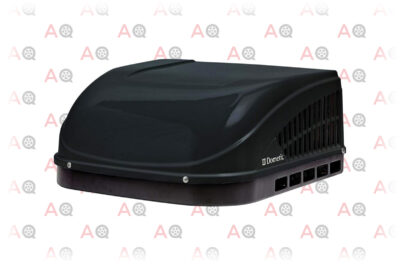
Editor’s Rating:
At a Glance:
- BTU: 15,000 BTU
- Installation type: Rooftop (ducted/non-ducted)
- Weight: 74 pounds
- Dimensions: 29.18 x 27.23 x 12.7 inches
The Dometic Brisk II covers almost every base there is when it comes to RV air conditioners.
The first question that springs to mind about a new air conditioner unit is whether it is easy to install. The Dometic Brisk II weighs 74 pounds, so you may need a step ladder and a helping hand to get it onto your RV. But once you’ve done that, it is just a 30-minute job to get it up and running.
Once the unit is atop the RV, start by bolting down the AC by lining it up with the holes on the vehicle. You can then attach the wires to get the unit powered and running. It’s really that simple.
With less powerful AC units, it can be hard to get the temperature in your vehicle under 80 degrees if it’s 95+ degrees outside. This RV air conditioner, however, can maintain temperatures in the low 70s even on very hot days.
Other times of the year, you may need an AC that provides heating. The Dometic Brisk II comes with a heat pump, so you can also use it to heat your RV, making it very versatile.
The Dometic Brisk II does, however, have a few minor shortcomings. Because of its impressive output, the Dometic Brisk II can be a little loud at times. Fencing off the air conditioner can help dampen some of the noise if it gets too annoying.
Although a great overall RV air conditioner, the Dometic Brisk II is not the most low-profile rooftop AC. If that’s what you’re looking for, then the Dometic Penguin II is a more appropriate product.
Pros
- Easy to install
- Comes with a heat pump
- Maintains cool temperatures easily
Cons
- Can be loud
- High-profile
2. Best Budget RV Air Conditioner: Frigidaire White Energy Star
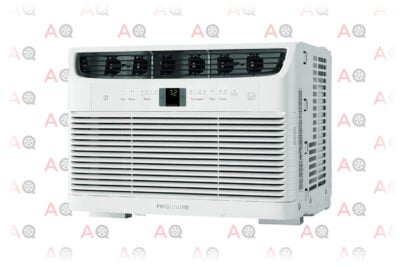
Editor’s Rating:
At a Glance
- BTU: 5,000 BTU
- Installation type: Window
- Weight: 49.2 pounds
- Dimensions: 17.75 x 17 x 14.75 inches
Sometimes, all you need is an air conditioner that can cool one room of your RV well – or you just have a small RV. If that’s what you’re looking for, then the Frigidaire White Energy Star is your best bet. Don’t let this product’s seemingly low 5,000 BTU rating fool you. It’s meant to be used for rooms up to 150 square feet in size. This makes it perfect for single rooms in your RV.
An added benefit of the Frigidaire White Energy Star’s modest aspirations is its energy efficiency. The product’s energy efficiency ratio (the ratio between cooling capacity in BTU to its input wattage) is 11.1. An EER value of 12 is considered very good for AC units, so this Frigidaire unit does well on that scale.
The Frigidaire White Energy Star is a window-mounted air conditioner. It comes with a window mounting kit so that you can go about installing it straight away.
This AC is perfect for RV owners looking to cool rooms of their vehicle on a budget. It consumes a low amount of energy and is relatively quiet as a result. This is the kind of product you’ll love if you own a smaller RV.
Portable ACs are also a great way to cool small rooms. The Black + Decker BPACT10WT is the most portable RV air conditioner on the market.
Pros
- Affordable
- Low energy requirements
- Relatively quiet
- Comes with window-mounting kit
Cons
- Can be used to cool only one room
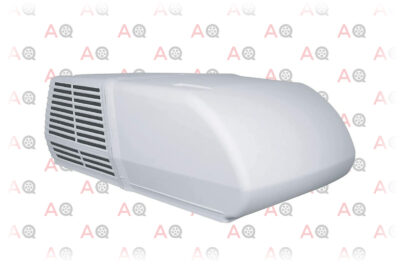
Editor’s Rating:
At a Glance
- BTU: 15,000 BTU
- Installation type: Rooftop (ducted/non-ducted)
- Weight: 90 pounds
- Dimensions: 42.00 x 28.00 x 16.00 inches
The real test of an RV air conditioner is whether it can keep you cool through searing temperatures outside. Let’s say you’re dealing with 110-degree dry heat in Arizona, for example. The Coleman Mach 15 is the kind of air conditioner that can keep your RV cool in those conditions without signs of being overworked. It can take inside temperatures from 90 degrees to 50 degrees in as little as 10 minutes.
Getting this RV air conditioner up and running is an easy process. The unit is designed for the 14×14 AC vent, which is standard, and the amount of wiring work required to kick it into action is minimal. It’s the kind of job most RV owners can do on their own. You will, however, need help getting the unit up onto your RV because of its weight.
Under the hood, the Coleman Mach 15 uses a combination of gas-flux joints and copper tubing. These combine with the condenser coils to create a system that can cool an RV for long hours in warm conditions. Since it is capable of high cooling output, this AC works best in a ducted setup. However, it can also be used as a non-ducted AC by using a ceiling assembly kit.
Pros
- Powerful cooling capabilities
- Easy install
- Sustained performance
Cons
- Heavy, you will need help hoisting it onto your RV
- Pricey
4. Most Portable RV Air Conditioner: Black + Decker BPACT10WT
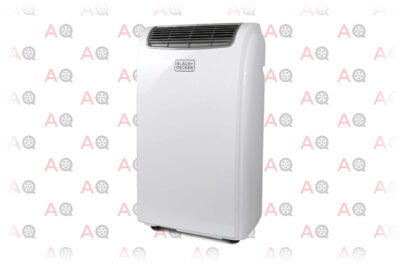
Editor’s Rating:
At a Glance:
- BTU: 10,000 BTU
- Installation type: Portable
- Weight: 52.9 pounds
- Dimensions: 16.5 x 11.5 x 26 inches
Portable air conditioners offer benefits that you can’t get with an AC that’s mounted in your window or roof. Firstly, they consume less energy than larger mounted units. They can also be moved around easily, which is something you can’t do with a mounted unit. The Black + Decker BPACT10WT offers these benefits in a product that performs supremely well.
This portable RV air conditioner comes in a compact body that can generate 10,000 BTU. This means that it is best suited for areas 250 square feet or under, which translates to RVs that are 31 feet in size. If you own an RV that falls within that size, you can’t do better than the Black + Decker BPACT10WT. If you need a portable RV air conditioner that is slightly more feature-rich and don’t mind some additional weight, the SereneLife SLACHT108 is a good choice.
This RV air conditioner offers three different modes that you can run it on. The first is the standard cool setting, for when you want to use it as an AC. On cooler days, you can switch to the fan setting just to keep the air flowing. It also offers a third dehumidifier mode. You can use this AC’s dehumidifying feature without having to deal with filling and emptying water containers. A hose adapter that comes with the product releases excess water out the window.
Pros
- Easily portable
- Compact body
- Multimode use
Cons
- Not fit for areas larger than 250 square feet
5. SereneLife SLACHT108
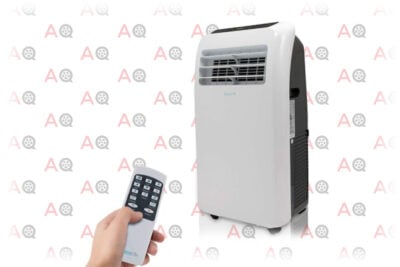
Editor’s Rating:
At a Glance:
- BTU: 10,000 BTU
- Installation type: Portable
- Weight: 62.6 pounds
- Dimensions: 17. 4 x 13. 4 x 32. 1 inches
RV owners usually equate portable air conditioners with compromising on certain kinds of features. And that’s true to some extent; you can’t expect the same cooling capacity as other kinds. However, as the SereneLife SLACHT108 shows, you can have your cake and eat it too with the right portable RV air conditioner.
Installing this AC is a quick process. Everything you need to get that done comes out of the box. This unit doesn’t take too much space, which is a boon for anyone who owns an RV.
Once you have it set up, there are a lot of features you can play around with. The SereneLife SLACHT108 has four operating modes: cooling, heating, dehumidifying, and a fan mode. You can use the remote control to set the mode as well as play around with the fan speed, temperature, and other things.
A major drawback with the SereneLife SLACHT108 is that it can be loud: very loud. This article shows you a few ways you can quiet down a loud RV air conditioner.
Pros
- Multi-mode operation
- Can be controlled remotely
- Easy to install
Cons
- Can be loud
6. Coleman Mach 3
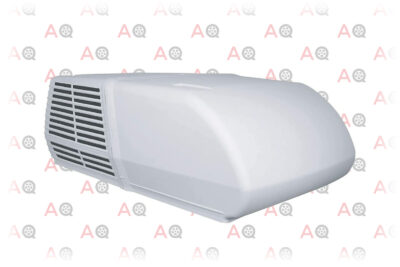
Editor’s Rating:
At a Glance:
- BTU: 13,500 BTU
- Installation type: Rooftop
- Weight: 79.5 pounds
- Dimensions: 41 x 28 x 16 inches
Let’s say it’s a hot day out there. The mercury touches 90 degrees, which means that it’s definitely time to get your RV air conditioner up and running. The Coleman Mach 3 is the kind of AC that can have the temperature inside your RV at about 70 degrees within 25 minutes. That’s the kind of cooling power you’re grateful for when it’s a hot day in the RV.
The hardest part about installing this RV air conditioner is getting it up on top of your RV. If you can get that done, you’re faced with a simple installation process. The 1-inch rubber seals that come with the unit have arrows that show you exactly how far to tighten them. After securing the AC to the RV, it’s very easy to plug in and power it up. The whole process takes only about an hour.
The Coleman Mach 3 works dependably for long periods of time. It is built well and you can expect to get multiple years of use from it. You may have a difficult time telling the difference between the different fan modes of the AC. But it works like a charm when you switch to the cooling mode.
Pros
- Easy to install
- Quick cooling
- Durable
Cons
- Different levels in the fan mode may not always feel very different
7. Best Low-Profile Rooftop RV Air Conditioner: Dometic Penguin II

Editor’s Rating:
At a Glance:
- BTU: 13,500 BTU
- Installation type: Rooftop (ducted/non-ducted)
- Weight: 118 pounds
- Dimensions: 42 x 30 x 12 inches
Most high-capacity RV air conditioners can be conspicuous and resource-intensive. And that’s why low-profile rooftop ACs like the Dometic Penguin II stand out. This is an AC that’s designed to maintain a low profile, which has several benefits.
The first big benefit of a low-profile rooftop air conditioner is that it reduces wind drag. The Dometic Penguin II sits low on your RV roof so that the entire vehicle is more aerodynamic. This is helpful for when you want to zip around in your RV and reduces fuel consumption over the long run.
The Dometic Penguin II does all of that without falling short in the performance department. It cranks out 13,500 BTU, which is sufficient capacity for RVs sized about 675 square feet – enough for almost all RVs on the market.
The one drawback with the Dometic Penguin II is that it doesn’t always maintain a low profile when it comes to the amount of noise it produces. But it’s never so loud that it is disruptive to your overall RV experience.
Pros
- Aerodynamic design
- Enhanced fuel usage
- Strong performance
Cons
- Can be loud at times
8. Best Window-Mounted RV Air Conditioner: Home Labs HME020003N

Editor’s Rating:
At a Glance:
- BTU: 5,000
- Installation type: Window
- Weight: 36.5 pounds
- Dimensions: 16 x 15.4 x 12 inches
The Home Labs HME020003N is built to be compact so that it can sit snugly in RV window units. The product has dimensions of 16 x 15.4 x 12 inches. The small size means that this air conditioner will fit in most windows unless you have extremely tiny windows in your RV.
Although this AC is small, it is by no means a flimsy product. The body is built using materials that feel premium. The buttons are sturdy and don’t feel like you’ll damage them quickly.
The Home Labs HME020003N is perfect for cooling small rooms. The 5,000 BTU it produces can quickly take a 150 square foot-sized room from warm to cold in a hurry. For larger spaces, however, you will need an air conditioner with a higher capacity.
This RV air conditioner produces some white noise, but isn’t what you’d consider loud. You can have the AC running and hear your TV without cranking the volume up to unreasonable levels. So this one is good for your RV and for your ears.
Pros
- Compatible with most RVs
- High-quality build
- Not overly noisy
Cons
- Not suitable for spaces above 150 square feet
9. Best RV Air Conditioner Air Distribution Box: Dometic 3314851

Editor’s Rating:
At a glance:
- Installation type: Rooftop attachment
- Weight: 10 pounds
- Dimensions: 23 x 21 x 2 inches
This one isn’t an RV air conditioner on its own but performs an important function as an AC accessory. The Dometic 3314851 is an air distribution box, which means that it distributes air channeled into it. It’s a great product to have when you have to use a non-ducted AC but want to circulate the air from it.
The Dometic 3314851 does that by first connecting to your existing rooftop air conditioner. If you have a roof that’s thicker than 4 inches, you will need to purchase the Dometic Bolt Kit to make the installation happen. This product works well with high-capacity ACs, such as ones with a rating of 15,000 BTU.
Once connected to the rooftop AC, the Dometic 3314851 distributes air evenly across your RV. The Dometic 3314851 also acts as a control unit for your AC.
Pros
- Distributes air from non-ducted ACs
- Can handle high-capacity air conditioners
- Doubles up as a control unit
Cons
- Requires additional accessory for roofs thicker than 4 inches
- Not a full AC unit
10. Best Non-Ducted RV Air Conditioner: Atwood 15026
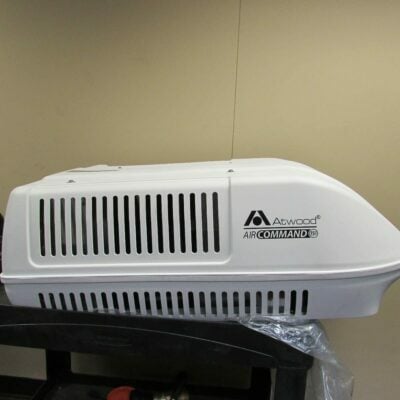
Editor’s Rating:
At a Glance:
- BTU: 15,000
- Installation type: Rooftop
- Weight: 88 pounds
- Dimensions: 40 x 28 x 15 inches
We saw that products like the Dometic Penguin II and Coleman Mach 15 can be used in both ducted and non-ducted setups. The Atwood 15026 is the first one on our list that works exclusively as a non-ducted RV air conditioner. Since it works only as a non-ducted AC, it’s a lot easier to set up in that environment.
This RV air conditioner has a capacity of 15,000 BTU, which means that it is more than sufficient to cool large spaces. But cooling is not the only thing it does. The heat pump that it comes with can be used to heat your RV if you’re suddenly faced with a cold day. That said, the heat pump can run into problems at lower temperatures. You may not get the heating levels you want at temperatures under 42 degrees.
Perhaps the best part about using the Atwood 15026 is that it comes with a remote. That means that you can control the AC without having to get up to change the temperature. Admit it: an AC that indulges your laziness is every RV owner’s dream.
Installing the Atwood 15026 couldn’t be any easier. Once you have it in the AC slot, you can attach it using the 4-bolt bracket. The gaskets come attached to the product. After attaching the unit, you can connect ground, neutral, and hot wires to get it running.
Pros
- Comes with a remote
- High capacity
- Easy to install
Cons
- Heat pump is not always dependable
Everything You Need to Know About RV Air Conditioners
Most RV air conditioners last a fairly long time. Choosing the right product for your RV is half the battle. Here are some other things you will have to deal with when it comes to RV air conditioners.
How to Install an RV Air Conditioner
The exact steps that you will follow to install an RV air conditioner depend both on the RV that you own and the AC that you buy. The specifics that you need to follow will be mentioned in the instruction manual that will come with the product. Here are a few general pointers to keep in mind. Note that these are assuming you’re installing a rooftop AC.
Always Unplug the Power
Disconnect the power to your existing AC and turn off the switch powering it in your breaker box. You don’t want any surprises when you make contact with the AC or any wiring that connects to it.
Create a Slot for the AC
Take some time to decide where in the roof of your RV the AC will go. Make sure that there aren’t any lights or anything else in the way. Choose a spot that’s at least ten inches from each edge of the roof.
Once you’ve found a slot that checks all those boxes, it’s time to make a hole in the roof. This part can be scary so only proceed if you’re sure of your ability to work with metal roofing and power tools. Make sure to mark where the bolts need to go after making the hole.
Mount the AC
It’s finally time to get that AC up on your RV. We’ve seen that some RV air conditioners can be heavy, so you may need some help with this. Once you have the unit up on the roof, secure it using the mounting bolts, the location of which you marked in the previous step. Then step into your RV and install the bolts that go into the ceiling of the vehicle.
You can apply a sealant to the areas where the AC makes contact with the RV’s metal roof. This lends additional stability to the installation.
Wire It Up
The final step involves connecting the wires in the AC to the RV. You can match the color of the wires to do this correctly. Refer to the instruction manual if you have any issues knowing where each wire goes.
If you get this part right, you should be able to turn the power on and have your AC up and running.
How to Refill an RV Air Conditioner
There will be times when you’ll need to provide some juice to your RV air conditioner externally. This usually happens because refrigerant levels in the unit need to be replenished. Refer to your AC’s instruction manual to find out what kind of refrigerant the vehicle uses.
Once you have the refrigerant, head up to your AC’s roof along with wrenches of a few different sizes. You can use those to take the lid off the AC. Make sure to lift the lid carefully so that you don’t damage it.
The refrigerant gauge under the lid is what will tell you how much additional refrigerant your RV is thirsting for. Check the gauge and unscrew the port to refill the refrigerant.
You may be eager to get that lid back on at this point, but not so fast. First, power your RV back on and test your AC’s cooling to make sure that it’s working properly again. After confirming that, head back up and get the lid back on.
How to Clean and Maintain an RV Air Conditioner
Using an RV air conditioner for a long time requires regular maintenance. There isn’t really a one-size-fits-all checklist that all RV owners can use to make sure that they’re maintaining their vehicle the right way. There are, however, a few different parts of the AC that you should check regularly to ensure they’re in good condition.
Filters
Anything clogging the filters of your AC is sure to reduce the airflow through it. This can hamper the overall performance of the unit because clogged filters make the compressor work harder, leading to overheating. So check the filters regularly and make sure that they’re clean.
Evaporator
The evaporator is the part of the AC that captures excess heat and transfers it outside your RV. The coils of the evaporator are usually made of copper and the fins are made of aluminum.
You can clean the evaporator by taking the shroud off its top and taking apart the plenum. You can use a coil cleaner to do the cleaning.
Compressor
The compressor is another important component of RV air conditioners. You don’t need to check on these too regularly; maybe just once or twice a year. The main thing you’re trying to do here is to get rid of the debris that tends to collect on the body of the compressor.
The easiest way to do that is by using a spray cleaner. These will unsettle the debris that sits on the compressor. You can then use a shop vac to clean up all the loosened debris.
Frequently Asked Questions About RV Air Conditioners
How Long Do RV Air Conditioners Last?
ACs from good brands, like the ones on this list, tend to last longer. We also just saw how it takes a fair amount of maintenance to keep your RV air conditioner running at optimal levels. If you get all of that right, you can expect your AC to last about five years on average.
How Much Does Installing an RV AC Cost?
Not everyone can install their RV air conditioner on their own, and that’s completely fine. If you need help installing a new AC, you can take it down to your shop. The price to install a new unit tends to be around $200-$300 on average.
How Do I Know When It’s Time for a New RV Air Conditioner?
If your AC isn’t working as you want it to, the first thing you need to do is check on a few components. First, check the fan motor to see if it’s working properly. You can use a multimeter to check if the motor is functioning like it should. If it is, move on to the compressor and check if it’s clean and working properly. Finally, check the refrigerant levels.
If both these parts seem fine and your refrigerant is topped up, and your AC is still not performing at its best, it may be time to consider a new AC unit.
The Cool Open Road
Travels that you undertake in an RV are meant to be carefree and relaxing. The best way to maintain that spirit of recreation is by choosing an air conditioner that can keep you feeling cool as you make your way down the open road.
We’ve covered the best of what’s out there and how you can choose which RV air conditioner is right for you. After making that choice, make sure to maintain the unit well so that you don’t have to think about another purchase for a while. And if you’re looking for ways to entertain yourself in your RV, check out our list of the best RV antennas.


